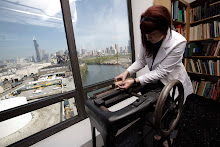
Barney Kulok's In Visisble Cities act as story telling and a map making device of sorts which bridge time between the past and present. How New York City's past is always so close to its present remained a constant theme throughout the readings made available in class. The past of New York City remains a reminder to all things before it, both tangible and not. Although New York City's urban milieu is constantly being recontextualized through literal demolitions and reconstructions, the oral history and memory of a place shifts too. How one's personal experience shapes a place and event, another's can be vastly different. This notion of how memory of time is made in a moment in history, like September 11th, is especially of note because arguably the event was felt so collectively, but each individual identification with the event is a little different. How an artist like Barney Kulok reshapes and makes new maps of seemingly familiar locales uses modern technology of mapping available WiFi networks he sees on his cellphone while walking familiar paths from known location to location, past to present, within New York CIty.
The process is as follows, in Kulok's own words:
In Visible Cities consists of three monochromatic panels and one photograph. To make each panel I began by choosing two points in Manhattan which would act as the frame. The titles of the pieces were chosen for places that once existed at these coordinates, but no longer exists today. I then walked between these sites and, using my phone, collected the names of all the WiFi networks that appeared on my screen along the route. I arranged the found text from each walk into grids and produced large stencils. On four-by-eight-foot aluminum panels I used acrylic paint and sprayed the ground black. Using the same pigment I then sprayed through the stencils, creating a field of names rising in low relief above the monochromatic surface. The resulting works are cameraless landscapes, invisible snapshots; representations of both the paths depicted and the moment of their recording, connecting the passage of time in the history of the city to the specific date the network names were recorded. This makes the project peculiarly photographic; the recording device has simply transformed from a camera into a phone.

Kulok's description of cameraless landscapes and the idea that even though his project is without an actual photograph, the process itself in inherently photographic because of the use of a recording device and the pinpointing of a specific place and the moment in which it is recorded. As New York City is a constantly changing place, Kulok's work is a connector for its locations' past lives as well as what those places operate as today. The way that Kulok's works operate within this project go a step further to demonstrate Michel de Certeau's statement that "what can be seen designates what is no longer there", in that the WiFi networks are there but invisible, they represent the inhabitants of places and spaces that have changed over the years. Kulok's In Visible Cities project serves to examine the changing surfaces of the street, public and private spaces. Kulok's works appear to be a way to blend the city, art and space. Even though the pieces are presented singularly within a group, the imagery examines the city as a series of the new and now, how situations are viewed in pieces, but act as a whole creating a background of their/our collective visual and verbal memory which is brought together to form a vision of composites.


No comments:
Post a Comment